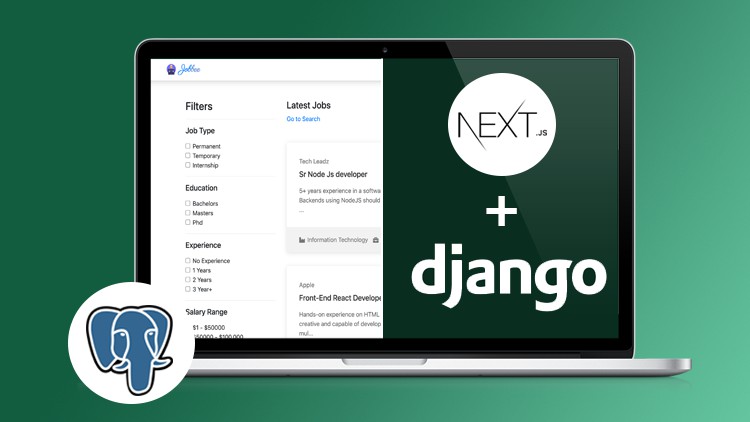Next.js & Django – Build Complete Jobs Portal with Postgres
Build a full-stack job portal app using Next.js and Django with Postgres, including authentication, rendering maps, and deployment.
What you’ll learn
Next.js & Django – Build Complete Jobs Portal with Postgres
- How to use the Django Rest Framework to create a REST API
- How to generate the address’s coordinates
- It’s all about simple JWT authentication.
- How to interact with Postgres databases
- How to deal with exceptions
- Learn how to use the API to create filters and pagination.
- How to Upload Files to AWS S3
- With Next JS, you can learn about server-side rendering.
- How to use Nextjs to add maps and locations.
- Learn how to pre-fetch data in a variety of ways.
- How to use Vercel with Heroku to launch a full-stack app.
- and a lot more.
Requirements
- You should be able to create APIs using the Django REST Framework.
- You should be familiar with React and Nextjs.
- Knowledge of key technologies such as Node, React, and Postgres is required.
- There’s nothing else except you and your limited time.
Description
Welcome to this Ultimate Full-stack course of the latest technologies Next.js & Django REST Framework if you want to construct a Full Stack App using Next.js & Django REST Framework.
Next.js is a production-ready react framework with all the capabilities you need for production: hybrid static and server rendering, route pre-fetching, and more. With three major characteristics, this is one of the most powerful tools:
- Routing based on files
- Rendering on the Server
- Development of full-stack applications
The Django REST framework, on the other hand, is a strong and versatile platform for creating Web APIs. It is one of Django’s most popular frameworks; it is user-friendly and has a lot of features. Serialization, filtering, pagination, exception handling, validation, authentication, and more features have made life much simpler.
So, to construct a comprehensive Full Stack Jobs Portal, we’ll use Next.js, Django, and Postgres. We’ll first produce an address’s coordinates and then present the map on the user interface. To create this full-stack project, we’ll stick to recommended practices.
The following are some of the features that will be added to this ready-to-use app:
- Add the Jobs resource to the mix.
- Obtaining Address Coordinates
- Pagination and Filtering are now available.
- Simple JWT for Complete Authentication
- Defending Routes Against Unauthorized Users
- Using AWS S3 to store files
- Mapquest is used to render maps.
- Handling Custom Exceptions
- Next.js for Server-Side Rendering
- The employer section is complete.
- Fill out a Job Application
- New Job Postings
- Recruiting Job Candidates
- Create topic statistics in the same way that Java does.
- Verify and deploy your app on Heroku.
The whole DEMO of this project is available in the course material. I’ll see you in the course if you’re ready to construct a production-ready, full-stack jobs portal app.
Who this course is for:
- Intermediate programmers interested in developing full-stack applications
- Developers that wish to learn how to develop applications using Django and Nextjs
- Anyone who enjoys learning about new technology.
Next.js & Django – Build Complete Jobs Portal with Postgres FreeCourseSites.com
How to create a WordPress site from scratch
Download Now









